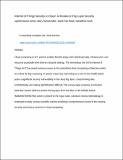| dc.description.abstract | Maize remains in demand due to its nutritive value, capacity to provide food for a growing world population, contribution to food security, and increase in worldwide investments in ethanol as a biofuel. However, the invasion and widespread infestation of Spodoptera frugiperda result in significant maize yield losses, leading to a lower standard of living and a weakened economy for maize producers. This study builds differentiable equations to simulate the behavior of the Spodoptera frugiperda-maize biomass model, incorporating predators and best farming practices. The model exhibits six points of equilibrium, all of which are locally asymptotically stable if the necessary requirements are met. Latin Hypercube Sampling (LHS) and PRCC multivariate analysis were employed to identify the sensitive parameters affecting the pest. Numerical simulations suggest that, in the early stages, integrating natural enemies with best farming practices proves to be an effective intervention as it directly reduces the pest population and promotes sustainable pest control. | en_US |

